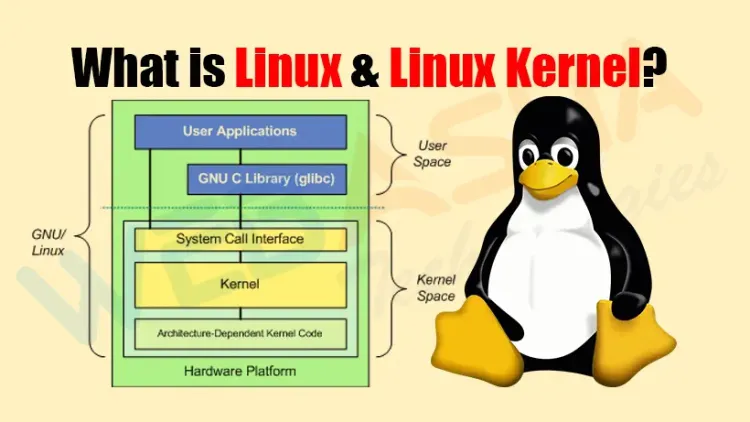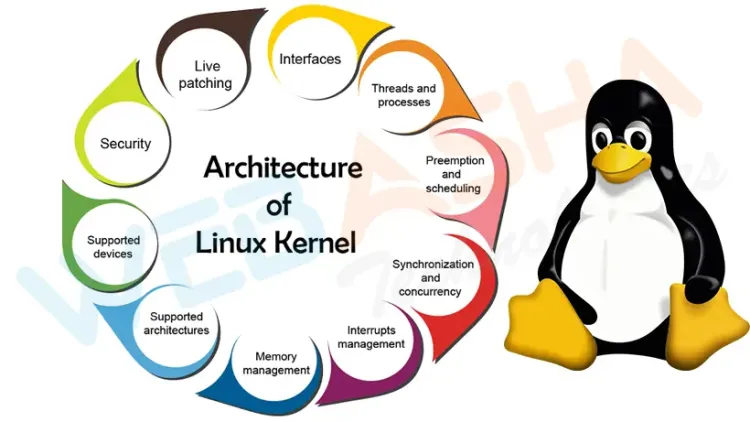What is Linux and Linux Kernel?
Uncover the essence of Linux and its powerful kernel. Explore the open-source operating system that has revolutionized computing. Learn about the Linux Kernel, the core of the system, driving innovation, and providing a robust foundation for diverse computing environments.

WHAT IS LINUX AND LINUX KERNEL
Based on the Linux Kernel, the Linux operating system is a kind of operating system that resembles Unix. Since the Linux Kernel controls how the computer communicates with its hardware and resources, it can be thought of as the operating system's brain. It ensures that everything functions properly and effectively. Nevertheless, a complete operating system cannot be created with just the Linux kernel. The Linux Kernel is coupled with an assortment of software packages and tools, together referred to as Linux distributions, to produce a complete and working system. With the help of these distributions, users can safely and efficiently run their apps and carry out operations on their computers using the Linux operating system.
What is Linux?
Like Unix, Linux is an open-source operating system kernel that serves as the foundation for many Linux distributions. Since Linus Torvalds founded it in 1991, Linux has developed into a powerful, dependable, and versatile operating system. Linux is widely used in many different computing scenarios, ranging from embedded systems and mobile devices to servers and PCs. It is renowned for having robust security measures and performance. Supercomputers, cloud services, and many web servers run on Linux.
Android runs on this operating system as well. Due to its open-source nature and versatility, it is a great choice for developers and companies searching for reasonably priced, flexible solutions.To create fully functional and user-friendly operating systems, Linux distributions such as Fedora, Ubuntu, Debian, and CentOS bundle additional software with the Linux kernel. Linux has become a global stalwart in the computer industry, powering a significant portion of servers, supercomputers, and embedded devices.
Key Features:-
-
Linux is distributed under open-source licenses, users are free to read, modify, and distribute it.
-
It promotes collaboration and community-driven development.
-
Allows multitasking , multiple programms can run simultaneously.
-
Linux has a strong security architecture with user-level rights, access controls, and the ability to enforce security policies.
-
It known for its stability and reliability.
-
It has numerous distributions.
-
It offers command-line as well as graphical interface.
What is Linux Kernel?
The Linux kernel was developed by Linus Torvalds in 1991 and serves as the foundation for these operating systems. As the core part of the operating system, it controls system resources and communicates directly with hardware. The kernel is responsible for managing memory, processing system calls, device drivers, file system management, and process management.Thanks to features like multitasking, multiuser support, and a robust security model, the Linux kernel forms the basis for a broad range of computing environments, from servers and desktops to embedded systems and mobile devices. Much of its popularity and extensive use may be ascribed to its modular architecture and continuous development inside the Linux operating system.

Key Features:-
-
It oversees the scheduling of processes, resource allocation, and interprocess communication.
-
The kernel is responsible for managing virtual memory, assigning memory to processes, and configuring the system's memory protection measures.
-
Hardware devices send out interrupt signals to request attention, and the kernel manages these signals.
-
The kernel enables communication between the hardware—such as printers, graphics cards, and storage—and the operating system.
-
guarantees the isolation and preservation of procedures and assets.
-
The networking protocols are managed by the kernel and allow devices connected to a network to communicate with each other.
Working of Linux
Multiple components interact to operate Linux, with the Linux kernel serving as the main hub for synchronizing system operations. When a Linux-powered machine is turned on, the bootloader initiates the process of loading the Linux kernel into memory. Subsequently, the kernel establishes a connection with the computer's hardware, manages device drivers, and sets up the system hardware. At kernel startup, the kernel starts the first user-space process that configures the user environment. This process is called init, or you can use a more modern name like systemd.
Multiple processes can run simultaneously thanks to the Linux kernel's management of multitasking, which also efficiently divides resources like CPU time and memory. User apps interact with the kernel through system calls, which instruct it to carry out operations on files or establish network connectivity. Data administration is made easier by the kernel's support for numerous file systems, and user and process isolation is ensured by its robust security mechanism.
Linux may be expanded and adapted because to its modular architecture and open-source status, which makes it suitable for a range of computing environments, including embedded systems, servers, and PCs. Owing to its focus on dependability, safety, and flexibility, the Linux operating model has been extensively embraced across numerous technological environments.
Conclusion
Based on the Linux Kernel, the Linux Operating System is a robust and adaptable open-source operating system that was covered in this article. It provides security, frequent updates, and a variety of distributions catered to user requirements, all supported by a cooperative worldwide community. Its architecture, which consists of the hardware layer, utilities, system libraries, kernel, and shell, guarantees effective operation. Linux has many advantages, such as great performance, reliability, and compatibility, but there are drawbacks, such as beginner-friendliness and a dearth of peripheral hardware drivers. In spite of this, Linux is still a major force in computing and is expected to grow and become more relevant throughout time.















![Top 10 Ethical Hackers in the World [2025]](https://www.webasha.com/blog/uploads/images/202408/image_100x75_66c2f983c207b.webp)








